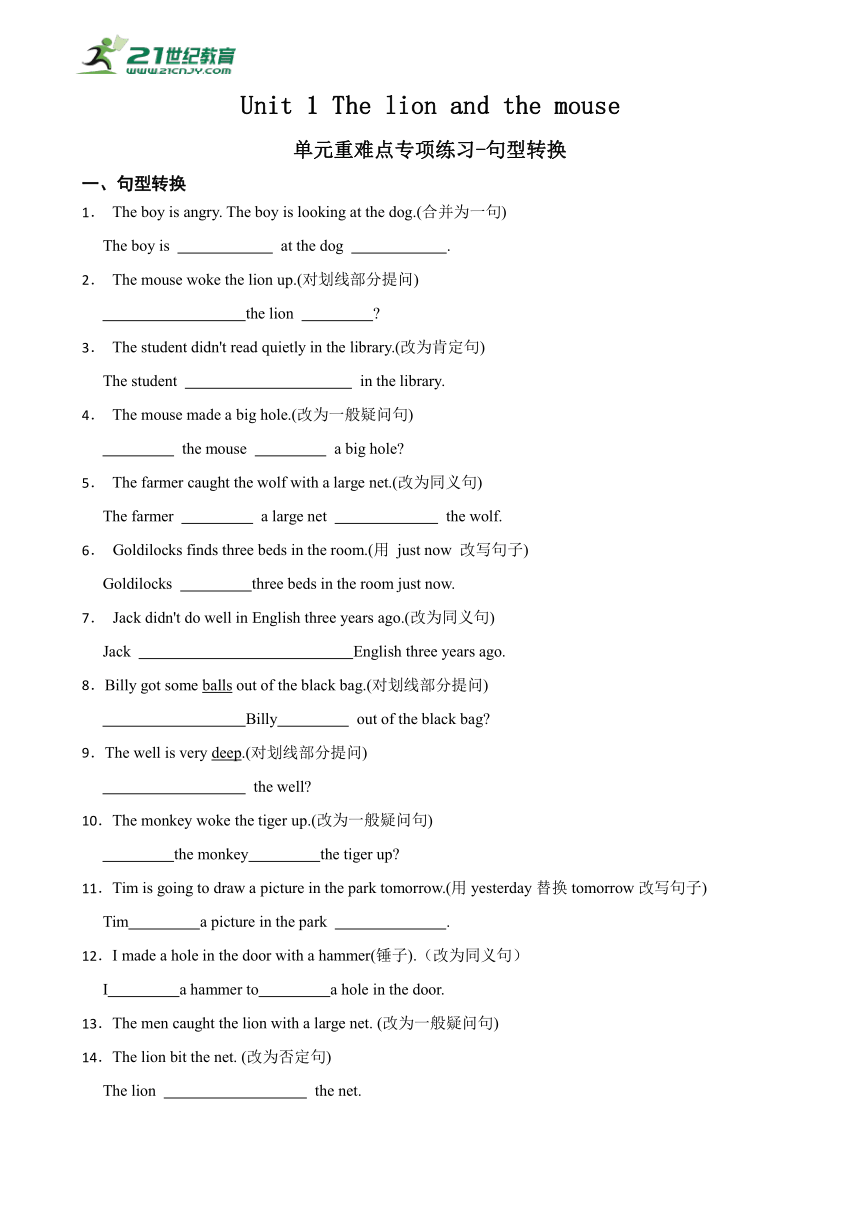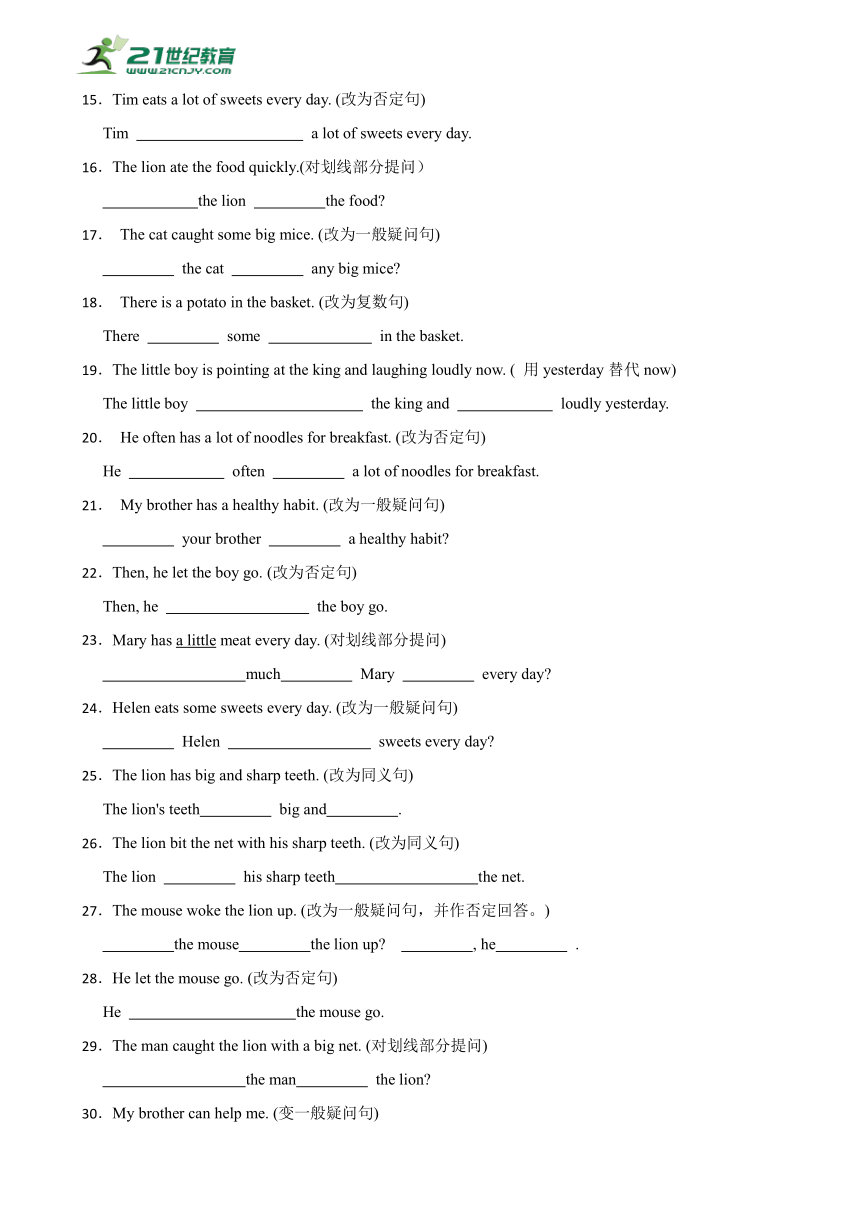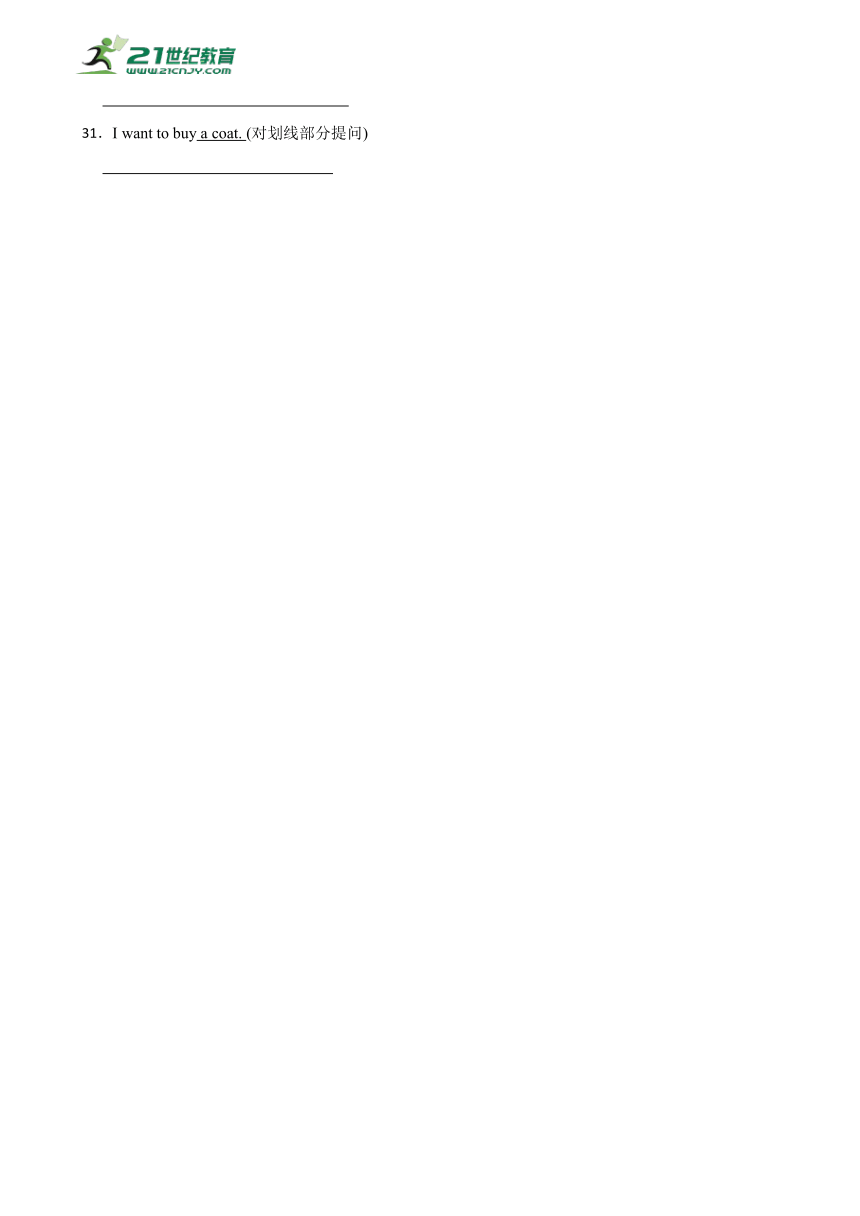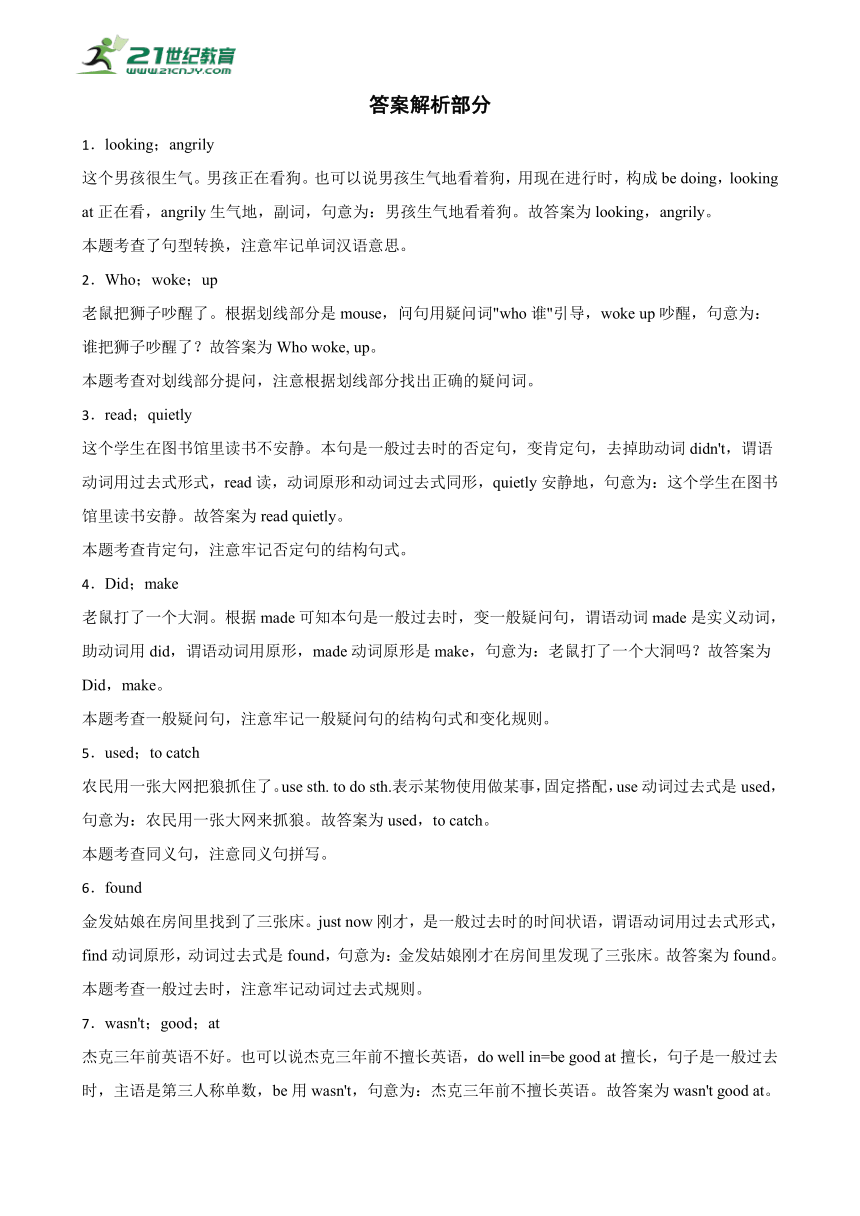Unit 1 The lion and the mouse 单元重难点易错点专项练习【含答案+解析】-句型转换六年级英语下学期(译林三起).docx
文档属性
| 名称 | Unit 1 The lion and the mouse 单元重难点易错点专项练习【含答案+解析】-句型转换六年级英语下学期(译林三起).docx |  | |
| 格式 | docx | ||
| 文件大小 | 41.6KB | ||
| 资源类型 | 试卷 | ||
| 版本资源 | 牛津译林版 | ||
| 科目 | 英语 | ||
| 更新时间 | 2025-02-06 18:09:29 | ||
图片预览




文档简介
Unit 1 The lion and the mouse
单元重难点专项练习-句型转换
一、句型转换
1. The boy is angry. The boy is looking at the dog.(合并为一句)
The boy is at the dog .
2. The mouse woke the lion up.(对划线部分提问)
the lion
3. The student didn't read quietly in the library.(改为肯定句)
The student in the library.
4. The mouse made a big hole.(改为一般疑问句)
the mouse a big hole
5. The farmer caught the wolf with a large net.(改为同义句)
The farmer a large net the wolf.
6. Goldilocks finds three beds in the room.(用 just now 改写句子)
Goldilocks three beds in the room just now.
7. Jack didn't do well in English three years ago.(改为同义句)
Jack English three years ago.
8.Billy got some balls out of the black bag.(对划线部分提问)
Billy out of the black bag
9.The well is very deep.(对划线部分提问)
the well
10.The monkey woke the tiger up.(改为一般疑问句)
the monkey the tiger up
11.Tim is going to draw a picture in the park tomorrow.(用yesterday替换tomorrow改写句子)
Tim a picture in the park .
12.I made a hole in the door with a hammer(锤子).(改为同义句)
I a hammer to a hole in the door.
13.The men caught the lion with a large net. (改为一般疑问句)
14.The lion bit the net. (改为否定句)
The lion the net.
15.Tim eats a lot of sweets every day. (改为否定句)
Tim a lot of sweets every day.
16.The lion ate the food quickly.(对划线部分提问)
the lion the food
17. The cat caught some big mice. (改为一般疑问句)
the cat any big mice
18. There is a potato in the basket. (改为复数句)
There some in the basket.
19.The little boy is pointing at the king and laughing loudly now. ( 用yesterday替代now)
The little boy the king and loudly yesterday.
20. He often has a lot of noodles for breakfast. (改为否定句)
He often a lot of noodles for breakfast.
21. My brother has a healthy habit. (改为一般疑问句)
your brother a healthy habit
22.Then, he let the boy go. (改为否定句)
Then, he the boy go.
23.Mary has a little meat every day. (对划线部分提问)
much Mary every day
24.Helen eats some sweets every day. (改为一般疑问句)
Helen sweets every day
25.The lion has big and sharp teeth. (改为同义句)
The lion's teeth big and .
26.The lion bit the net with his sharp teeth. (改为同义句)
The lion his sharp teeth the net.
27.The mouse woke the lion up. (改为一般疑问句,并作否定回答。)
the mouse the lion up , he .
28.He let the mouse go. (改为否定句)
He the mouse go.
29.The man caught the lion with a big net. (对划线部分提问)
the man the lion
30.My brother can help me. (变一般疑问句)
31.I want to buy a coat. (对划线部分提问)
答案解析部分
1.looking;angrily
这个男孩很生气。男孩正在看狗。也可以说男孩生气地看着狗,用现在进行时,构成be doing,looking at正在看,angrily生气地,副词,句意为:男孩生气地看着狗。故答案为looking,angrily。
本题考查了句型转换,注意牢记单词汉语意思。
2.Who;woke;up
老鼠把狮子吵醒了。根据划线部分是mouse,问句用疑问词"who谁"引导,woke up吵醒,句意为:谁把狮子吵醒了?故答案为Who woke, up。
本题考查对划线部分提问,注意根据划线部分找出正确的疑问词。
3.read;quietly
这个学生在图书馆里读书不安静。本句是一般过去时的否定句,变肯定句,去掉助动词didn't,谓语动词用过去式形式,read读,动词原形和动词过去式同形,quietly安静地,句意为:这个学生在图书馆里读书安静。故答案为read quietly。
本题考查肯定句,注意牢记否定句的结构句式。
4.Did;make
老鼠打了一个大洞。根据made可知本句是一般过去时,变一般疑问句,谓语动词made是实义动词,助动词用did,谓语动词用原形,made动词原形是make,句意为:老鼠打了一个大洞吗?故答案为Did,make。
本题考查一般疑问句,注意牢记一般疑问句的结构句式和变化规则。
5.used;to catch
农民用一张大网把狼抓住了。use sth. to do sth.表示某物使用做某事,固定搭配,use动词过去式是used,句意为:农民用一张大网来抓狼。故答案为used,to catch。
本题考查同义句,注意同义句拼写。
6.found
金发姑娘在房间里找到了三张床。just now刚才,是一般过去时的时间状语,谓语动词用过去式形式,find动词原形,动词过去式是found,句意为:金发姑娘刚才在房间里发现了三张床。故答案为found。
本题考查一般过去时,注意牢记动词过去式规则。
7.wasn't;good;at
杰克三年前英语不好。也可以说杰克三年前不擅长英语,do well in=be good at擅长,句子是一般过去时,主语是第三人称单数,be用wasn't,句意为:杰克三年前不擅长英语。故答案为wasn't good at。
本题考查了同义句,注意牢记同义句拼写。
8.What;did;get
比利从黑书包里取出一些球。根据划线部分是some balls一些球,是某物,问句用疑问词"what什么"引导,后面接一般疑问句;句子是一般过去时,用助动词did,谓语动词用原形,get动词原形是got,句意为:比利从黑书包里取出了什么?故答案为What did,got。
本题考查对划线部分提问,注意先根据划线部分写出疑问词。
9.How;is
井很深。根据划线部分是形容词deep,问句用疑问词"how怎么样"引导,后面接一般疑问句,将is提到句首,句意为:井怎么样?故答案为How is。
本题考查对划线部分提问,注意先根据划线部分写出疑问词。
10.Did;wake
猴子把老虎叫醒了。题意要求改为一般疑问句,此句是含有实意动词的句子,又是一般过去时态,变一般疑问句要借助动词did,助动词后要用动词原形,woke原形wake,故答案为Did;wake。
此题考查一般疑问句,要掌握一般疑问句的变化规则。
11.drew;yesterday
蒂姆打算明天在公园里画一幅画。题意要求用yesterday替换tomorrow,也就是把一般将来时改为一般过去时,动词draw要用过去式,draw过去式drew,故答案为drew;yesterday。
此题考查一般过去时,掌握一般过去时态中动词过去式的变化。
12.used;make
我用锤子在门上做了一个洞。题意要求改为同义句,with a hammer用锤子,是介词短语,同义于动词短语,use+某物+to +动词原形,表示用某物来做某事,use a hammer to make a hole用锤子做了一个洞。又因原句是一般过去时,同义句也用一般过去时,use过去式used,故答案为used;make。
此题考查同义句,要掌握同义句的同义短语。
13.Did the men catch the lion with a large net?
这个人用一个大笼子抓住那只狮子。caught是catch的过去式,构成一般疑问句需要助动词did放在句首,用“Did+主语+动词原形+其他成分”的结构完成句子,首字母大写,句末加问号,故答案为Did the men catch the lion with a large net?
本题主要考查一般过去时的一般疑问句,注意首字母大写和句末的标点符号。
14.didn't;bite
狮子咬了网。主语是名词单数,谓语动词bit是"bite咬"的动词过去式,变否定句,用助动词didn't,谓语动词用原形bite,句意为:狮子没有咬网。故答案为didn't,bite。
本题考查了句型转换,注意牢记一般过去时的否定句的结构句式。
15.doesn't;eat
蒂姆每天吃很多糖果。本句是一般现在时,主语是第三人称单数,谓语动词eats是实义动词,变否定句,用助动词doesn't,谓语动词用原形,eats动词原形是eat,句意为:蒂姆每天没有吃很多糖果。故答案为doesn't,eat。
本题考查了句型转换,注意牢记否定句的结构句式。
16.How did;eat
狮子快速地吃了食物。划线部分是副词quickly,对副词提问要用how怎样,狮子怎样吃的食物,然后把剩下的句子变成一般疑问句。此句是一般过去时,要借助动词did,然后后面用动词原形eat,故答案为How did;eat。
此题考查对划线部分提问,要掌握对划线部分提问做题方法。
17.Did;catch
那只猫抓了一些大老鼠。本句是一般过去时,谓语动词caught是实义动词,助动词用did,变一般疑问句,助动词用did,谓语动词用原形,caught动词原形是catch,句意为:那只猫抓了一些大老鼠吗?故答案为Did,catch。
本题考查了句型转换,注意牢记一般过去时的一般疑问句的结构句式。
18.are;potatoes
篮子里有一个土豆。is复数是are,potato土豆,复数是potatoes,句意为:篮子里有一些土豆。故答案为are,potatoes。
本题考查了句型转换,注意牢记单词的单复数形式。
19.pointed;at;laughed
这个小男孩指着国王大笑起来。yesterday昨天,是一般过去时的时间状语,谓语动词用过去式形式,pointing at指着,动词过去式是pointed at,laughing动词过去式是laughed,句意为:昨天那个小男孩指着国王大笑起来。故答案为pointed,at,laughed。
本题考查了句型转换,注意牢记动词过去式规则。
20.doesn't;have
他早餐经常吃很多面条。本句是一般现在时,主语是第三人称单数,谓语动词has是熬夜的查,变否定句,助动词用doesn't,谓语动词用原形,has动词原形是have,句意为:他早餐没有经常吃很多面条。故答案为doesn't,have。
本题考查了句型转换,注意牢记否定句的结构句式。
21.Does;have
我哥哥有一个健康的习惯。本句是一般现在时,主语是第三人称单数,谓语动词has是实义动词,助动词用does,谓语动词用原形,has动词原形是have,句意为:你的哥哥有一个健康的习惯吗?故答案为Does,have。
本题考查了句型转换,注意牢记一般疑问句的结构句式。
22.didn't;let
然后,他放走了那个男孩。本句是一般过去时的否定句,谓语动词let是实义动词,助动词用didn't,谓语动词用原形,let动词原形和动词过去式同形,句意为:然后,他没有放走了那个男孩。故答案为didn't,let。
本题考查了句型转换,注意牢记一般过去时的否定句的结构句式。
23.How;meat;does;have
玛丽每天吃一点肉。根据划线部分是形容词,问句用疑问词how much多少引导,后面接名词meat,后面接一般疑问句,主语是第三人称单数,助动词用does,谓语动词用原形has动词原形have,句意为:玛丽每天吃多少肉?故答案为How,meat,does,have。
本题考查了句型转换,注意先根据划线部分写出疑问词。
24.Does;eat;any
海伦每天吃一些糖果。本句是一般现在时,主语是第三人称单数,谓语动词eats是实义动词,变一般疑问句,用助动词does,谓语动词用原形,eats动词原形eat,some变any,句意为:海伦每天吃一些糖果吗?故答案为Does,eat,any。
本题考查了句型转换,注意牢记一般疑问句的结构句式。
25.are;sharp
根据 The lion has big and sharp teeth 可知,此句的含义为“老虎有又大又锋利的牙齿”也就是说“老虎的牙齿又大又锋利”,两句时态保持一致,用一般现在时,主语为teeth(名词复数),空一be动词要用are;sharp锋利的,形容词,空二处作表语。故答案为are,sharp。
考查句型转换。此处注意同义句的变换。
26.used;to;bite
根据 The lion bit the net with his sharp teeth. 可知,此句的含义为“狮子用锋利的牙齿咬网”,use...to do sth用......做某事,固定短语,两句时态保持一致为一般过去时,所以空一要用过去式used,bite咬,动词,此处要用动词不定式形式,故答案为used,to,bite。
考查句型转换。掌握原题干意思,找出同义短语。
27.Did;wake;No;didn't
根据 The mouse woke the lion up 可知,此句为一般过去时,woke为动词过去式,变成一般疑问句需用助动词did构成句子结构,句首字母大写,woke变成动词原形,回答也要用助动词,故答案为Did,wake,No,didn't。
考查句型转换。掌握一般疑问句的变形。
28.doesn't;let
根据 He let the mouse go 可知,此句为一般现在时,let为实义动词,构成否定句需用助动词,此处主语为He(第三人称单数),所以助动词要用doesn't,let用原形,故答案为doesn't,let。
考查句型转换。掌握一般现在时否定句的变形。
29.How;did;catch
那个人用一张大网捉住了一只狮子。划线部分为 with a big net 表示方式,要用疑问词how引导特殊疑问句,句首字母大写,剩余句子变成一般疑问句,两句时态要保持一致,用一般过去时,caught为catch的过去式,实义动词,一般疑问句需用助动词did构成句子结构,caught变成动词原形,故答案为How,did,catch。
考查句型转换。掌握how引导的特殊疑问句。
30.Can your brother help you
我哥哥能帮我。改为一般疑问句需要把can提到句首,首字母大写,剩余部分按顺序抄下来,第一人称换成第二人称,句末加问号,故答案为Can your brother help you
本题主要考查一般疑问句,注意首字母大写和人称的变化。
31.What do you want to buy
我想买件外套。就划线部分提问,就是变成特殊疑问句,其结构是:特殊疑问词+一般疑问句;该句子需要主动do构成问句;该句子提问宾语(事物),因此用what代替划线部分,首字母大写,句末加问号,第一人称变为的人称,故答案为What do you want to buy
本题考查的特殊疑问句,注意本句子中的特殊疑问词及助动词do的用法。
单元重难点专项练习-句型转换
一、句型转换
1. The boy is angry. The boy is looking at the dog.(合并为一句)
The boy is at the dog .
2. The mouse woke the lion up.(对划线部分提问)
the lion
3. The student didn't read quietly in the library.(改为肯定句)
The student in the library.
4. The mouse made a big hole.(改为一般疑问句)
the mouse a big hole
5. The farmer caught the wolf with a large net.(改为同义句)
The farmer a large net the wolf.
6. Goldilocks finds three beds in the room.(用 just now 改写句子)
Goldilocks three beds in the room just now.
7. Jack didn't do well in English three years ago.(改为同义句)
Jack English three years ago.
8.Billy got some balls out of the black bag.(对划线部分提问)
Billy out of the black bag
9.The well is very deep.(对划线部分提问)
the well
10.The monkey woke the tiger up.(改为一般疑问句)
the monkey the tiger up
11.Tim is going to draw a picture in the park tomorrow.(用yesterday替换tomorrow改写句子)
Tim a picture in the park .
12.I made a hole in the door with a hammer(锤子).(改为同义句)
I a hammer to a hole in the door.
13.The men caught the lion with a large net. (改为一般疑问句)
14.The lion bit the net. (改为否定句)
The lion the net.
15.Tim eats a lot of sweets every day. (改为否定句)
Tim a lot of sweets every day.
16.The lion ate the food quickly.(对划线部分提问)
the lion the food
17. The cat caught some big mice. (改为一般疑问句)
the cat any big mice
18. There is a potato in the basket. (改为复数句)
There some in the basket.
19.The little boy is pointing at the king and laughing loudly now. ( 用yesterday替代now)
The little boy the king and loudly yesterday.
20. He often has a lot of noodles for breakfast. (改为否定句)
He often a lot of noodles for breakfast.
21. My brother has a healthy habit. (改为一般疑问句)
your brother a healthy habit
22.Then, he let the boy go. (改为否定句)
Then, he the boy go.
23.Mary has a little meat every day. (对划线部分提问)
much Mary every day
24.Helen eats some sweets every day. (改为一般疑问句)
Helen sweets every day
25.The lion has big and sharp teeth. (改为同义句)
The lion's teeth big and .
26.The lion bit the net with his sharp teeth. (改为同义句)
The lion his sharp teeth the net.
27.The mouse woke the lion up. (改为一般疑问句,并作否定回答。)
the mouse the lion up , he .
28.He let the mouse go. (改为否定句)
He the mouse go.
29.The man caught the lion with a big net. (对划线部分提问)
the man the lion
30.My brother can help me. (变一般疑问句)
31.I want to buy a coat. (对划线部分提问)
答案解析部分
1.looking;angrily
这个男孩很生气。男孩正在看狗。也可以说男孩生气地看着狗,用现在进行时,构成be doing,looking at正在看,angrily生气地,副词,句意为:男孩生气地看着狗。故答案为looking,angrily。
本题考查了句型转换,注意牢记单词汉语意思。
2.Who;woke;up
老鼠把狮子吵醒了。根据划线部分是mouse,问句用疑问词"who谁"引导,woke up吵醒,句意为:谁把狮子吵醒了?故答案为Who woke, up。
本题考查对划线部分提问,注意根据划线部分找出正确的疑问词。
3.read;quietly
这个学生在图书馆里读书不安静。本句是一般过去时的否定句,变肯定句,去掉助动词didn't,谓语动词用过去式形式,read读,动词原形和动词过去式同形,quietly安静地,句意为:这个学生在图书馆里读书安静。故答案为read quietly。
本题考查肯定句,注意牢记否定句的结构句式。
4.Did;make
老鼠打了一个大洞。根据made可知本句是一般过去时,变一般疑问句,谓语动词made是实义动词,助动词用did,谓语动词用原形,made动词原形是make,句意为:老鼠打了一个大洞吗?故答案为Did,make。
本题考查一般疑问句,注意牢记一般疑问句的结构句式和变化规则。
5.used;to catch
农民用一张大网把狼抓住了。use sth. to do sth.表示某物使用做某事,固定搭配,use动词过去式是used,句意为:农民用一张大网来抓狼。故答案为used,to catch。
本题考查同义句,注意同义句拼写。
6.found
金发姑娘在房间里找到了三张床。just now刚才,是一般过去时的时间状语,谓语动词用过去式形式,find动词原形,动词过去式是found,句意为:金发姑娘刚才在房间里发现了三张床。故答案为found。
本题考查一般过去时,注意牢记动词过去式规则。
7.wasn't;good;at
杰克三年前英语不好。也可以说杰克三年前不擅长英语,do well in=be good at擅长,句子是一般过去时,主语是第三人称单数,be用wasn't,句意为:杰克三年前不擅长英语。故答案为wasn't good at。
本题考查了同义句,注意牢记同义句拼写。
8.What;did;get
比利从黑书包里取出一些球。根据划线部分是some balls一些球,是某物,问句用疑问词"what什么"引导,后面接一般疑问句;句子是一般过去时,用助动词did,谓语动词用原形,get动词原形是got,句意为:比利从黑书包里取出了什么?故答案为What did,got。
本题考查对划线部分提问,注意先根据划线部分写出疑问词。
9.How;is
井很深。根据划线部分是形容词deep,问句用疑问词"how怎么样"引导,后面接一般疑问句,将is提到句首,句意为:井怎么样?故答案为How is。
本题考查对划线部分提问,注意先根据划线部分写出疑问词。
10.Did;wake
猴子把老虎叫醒了。题意要求改为一般疑问句,此句是含有实意动词的句子,又是一般过去时态,变一般疑问句要借助动词did,助动词后要用动词原形,woke原形wake,故答案为Did;wake。
此题考查一般疑问句,要掌握一般疑问句的变化规则。
11.drew;yesterday
蒂姆打算明天在公园里画一幅画。题意要求用yesterday替换tomorrow,也就是把一般将来时改为一般过去时,动词draw要用过去式,draw过去式drew,故答案为drew;yesterday。
此题考查一般过去时,掌握一般过去时态中动词过去式的变化。
12.used;make
我用锤子在门上做了一个洞。题意要求改为同义句,with a hammer用锤子,是介词短语,同义于动词短语,use+某物+to +动词原形,表示用某物来做某事,use a hammer to make a hole用锤子做了一个洞。又因原句是一般过去时,同义句也用一般过去时,use过去式used,故答案为used;make。
此题考查同义句,要掌握同义句的同义短语。
13.Did the men catch the lion with a large net?
这个人用一个大笼子抓住那只狮子。caught是catch的过去式,构成一般疑问句需要助动词did放在句首,用“Did+主语+动词原形+其他成分”的结构完成句子,首字母大写,句末加问号,故答案为Did the men catch the lion with a large net?
本题主要考查一般过去时的一般疑问句,注意首字母大写和句末的标点符号。
14.didn't;bite
狮子咬了网。主语是名词单数,谓语动词bit是"bite咬"的动词过去式,变否定句,用助动词didn't,谓语动词用原形bite,句意为:狮子没有咬网。故答案为didn't,bite。
本题考查了句型转换,注意牢记一般过去时的否定句的结构句式。
15.doesn't;eat
蒂姆每天吃很多糖果。本句是一般现在时,主语是第三人称单数,谓语动词eats是实义动词,变否定句,用助动词doesn't,谓语动词用原形,eats动词原形是eat,句意为:蒂姆每天没有吃很多糖果。故答案为doesn't,eat。
本题考查了句型转换,注意牢记否定句的结构句式。
16.How did;eat
狮子快速地吃了食物。划线部分是副词quickly,对副词提问要用how怎样,狮子怎样吃的食物,然后把剩下的句子变成一般疑问句。此句是一般过去时,要借助动词did,然后后面用动词原形eat,故答案为How did;eat。
此题考查对划线部分提问,要掌握对划线部分提问做题方法。
17.Did;catch
那只猫抓了一些大老鼠。本句是一般过去时,谓语动词caught是实义动词,助动词用did,变一般疑问句,助动词用did,谓语动词用原形,caught动词原形是catch,句意为:那只猫抓了一些大老鼠吗?故答案为Did,catch。
本题考查了句型转换,注意牢记一般过去时的一般疑问句的结构句式。
18.are;potatoes
篮子里有一个土豆。is复数是are,potato土豆,复数是potatoes,句意为:篮子里有一些土豆。故答案为are,potatoes。
本题考查了句型转换,注意牢记单词的单复数形式。
19.pointed;at;laughed
这个小男孩指着国王大笑起来。yesterday昨天,是一般过去时的时间状语,谓语动词用过去式形式,pointing at指着,动词过去式是pointed at,laughing动词过去式是laughed,句意为:昨天那个小男孩指着国王大笑起来。故答案为pointed,at,laughed。
本题考查了句型转换,注意牢记动词过去式规则。
20.doesn't;have
他早餐经常吃很多面条。本句是一般现在时,主语是第三人称单数,谓语动词has是熬夜的查,变否定句,助动词用doesn't,谓语动词用原形,has动词原形是have,句意为:他早餐没有经常吃很多面条。故答案为doesn't,have。
本题考查了句型转换,注意牢记否定句的结构句式。
21.Does;have
我哥哥有一个健康的习惯。本句是一般现在时,主语是第三人称单数,谓语动词has是实义动词,助动词用does,谓语动词用原形,has动词原形是have,句意为:你的哥哥有一个健康的习惯吗?故答案为Does,have。
本题考查了句型转换,注意牢记一般疑问句的结构句式。
22.didn't;let
然后,他放走了那个男孩。本句是一般过去时的否定句,谓语动词let是实义动词,助动词用didn't,谓语动词用原形,let动词原形和动词过去式同形,句意为:然后,他没有放走了那个男孩。故答案为didn't,let。
本题考查了句型转换,注意牢记一般过去时的否定句的结构句式。
23.How;meat;does;have
玛丽每天吃一点肉。根据划线部分是形容词,问句用疑问词how much多少引导,后面接名词meat,后面接一般疑问句,主语是第三人称单数,助动词用does,谓语动词用原形has动词原形have,句意为:玛丽每天吃多少肉?故答案为How,meat,does,have。
本题考查了句型转换,注意先根据划线部分写出疑问词。
24.Does;eat;any
海伦每天吃一些糖果。本句是一般现在时,主语是第三人称单数,谓语动词eats是实义动词,变一般疑问句,用助动词does,谓语动词用原形,eats动词原形eat,some变any,句意为:海伦每天吃一些糖果吗?故答案为Does,eat,any。
本题考查了句型转换,注意牢记一般疑问句的结构句式。
25.are;sharp
根据 The lion has big and sharp teeth 可知,此句的含义为“老虎有又大又锋利的牙齿”也就是说“老虎的牙齿又大又锋利”,两句时态保持一致,用一般现在时,主语为teeth(名词复数),空一be动词要用are;sharp锋利的,形容词,空二处作表语。故答案为are,sharp。
考查句型转换。此处注意同义句的变换。
26.used;to;bite
根据 The lion bit the net with his sharp teeth. 可知,此句的含义为“狮子用锋利的牙齿咬网”,use...to do sth用......做某事,固定短语,两句时态保持一致为一般过去时,所以空一要用过去式used,bite咬,动词,此处要用动词不定式形式,故答案为used,to,bite。
考查句型转换。掌握原题干意思,找出同义短语。
27.Did;wake;No;didn't
根据 The mouse woke the lion up 可知,此句为一般过去时,woke为动词过去式,变成一般疑问句需用助动词did构成句子结构,句首字母大写,woke变成动词原形,回答也要用助动词,故答案为Did,wake,No,didn't。
考查句型转换。掌握一般疑问句的变形。
28.doesn't;let
根据 He let the mouse go 可知,此句为一般现在时,let为实义动词,构成否定句需用助动词,此处主语为He(第三人称单数),所以助动词要用doesn't,let用原形,故答案为doesn't,let。
考查句型转换。掌握一般现在时否定句的变形。
29.How;did;catch
那个人用一张大网捉住了一只狮子。划线部分为 with a big net 表示方式,要用疑问词how引导特殊疑问句,句首字母大写,剩余句子变成一般疑问句,两句时态要保持一致,用一般过去时,caught为catch的过去式,实义动词,一般疑问句需用助动词did构成句子结构,caught变成动词原形,故答案为How,did,catch。
考查句型转换。掌握how引导的特殊疑问句。
30.Can your brother help you
我哥哥能帮我。改为一般疑问句需要把can提到句首,首字母大写,剩余部分按顺序抄下来,第一人称换成第二人称,句末加问号,故答案为Can your brother help you
本题主要考查一般疑问句,注意首字母大写和人称的变化。
31.What do you want to buy
我想买件外套。就划线部分提问,就是变成特殊疑问句,其结构是:特殊疑问词+一般疑问句;该句子需要主动do构成问句;该句子提问宾语(事物),因此用what代替划线部分,首字母大写,句末加问号,第一人称变为的人称,故答案为What do you want to buy
本题考查的特殊疑问句,注意本句子中的特殊疑问词及助动词do的用法。
